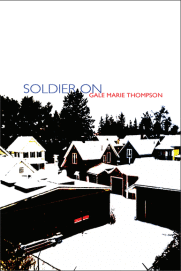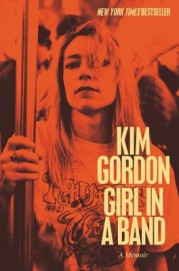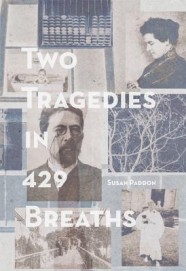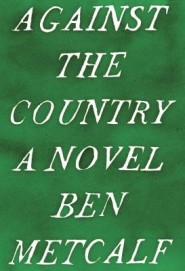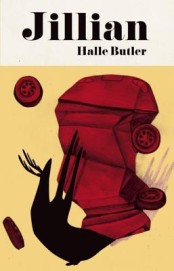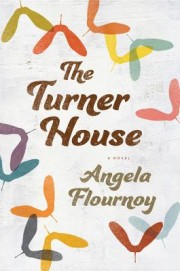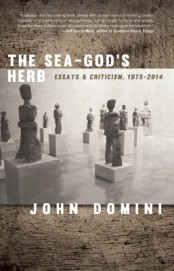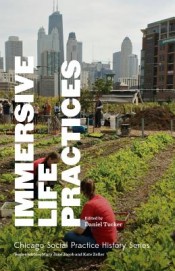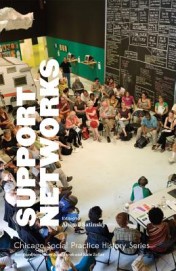
by Dylan Hicks
One of the sharpest music critics to become prominent in the 1990s, Eric Weisbard wrote for Spin, the Village Voice, and the New York Times, and edited, with Craig Marks, 1995’s enduringly useful Spin Alternative Record Guide (whose contributors include future novelists Colson Whitehead and James Hannaham). He’s also the founder and organizer of the EMP Pop Conference—an annual gathering of music scholars, journalists, practitioners, and professionals that has helped shape critical discourse since its inception in 2002—and has edited three collections of presentations from the conference.
Weisbard’s inventively researched and subtly argued new book, Top 40 Democracy: The Rival Mainstreams of American Music (University of Chicago Press, $27.50), looks at postwar popular music through the formats radio programmers and record companies developed to present it. It’s in part a celebration of the yield from these “rival mainstreams.” In his introduction, Weisbard recalls wondering “how the range of hits produced by the supposedly stifling corporate structures of radio and records effortlessly—and without an ounce of idealism required—exceeded rock in its range of sounds, artists, audience, and creativity. Could one account for this, but also for the fact that so much eclecticism had been met with so much scorn?”
We conducted this conversation over a few hours via email, Weisbard responding from Tuscaloosa, where he is an assistant professor of American Studies at the University of Alabama.
DYLAN HICKS: Top 40 Democracy, among other things, reframes the contraries known as “rockism” and “poptimism.” Because some readers might not be familiar with these terms, I’ll attempt a summary, which you might need to correct. Rockism (typically defined by its opponents) endorses certain humanist, bohemian, folky, and jazz ideals—authenticity, individualism, autonomy, rebellion, incorruptibility—and favors modes of operation thought to be common to the more celebrated post-Dylan-and-Beatles rock artists: playing, for instance, self-penned, self-expressive songs on relatively traditional instruments in real time, or at least using the studio to simulate live performance; following artistic rather than commercial impulses, or, short of that, cloaking or ironizing venality. The poptimist view—more fashionable over the past decade or so—highlights the frequent spuriousness of rock’s authenticity claims; points to sexism, racism, homophobia, and classism explicit or implicit in rockism; and shows how radio pop, despite its mutating rigidities, has often welcomed difference. “Top 40 needs to be understood as a format of outsiders opting in,” you write, “where rock prized opting out.” While not necessarily rejecting the rock canon, poptimism argues that the blanket dismissal of mainstream pop—or pop’s “rival mainstreams,” in your formulation—is inherently antidemocratic and sociologically incurious; poptimism encourages the guilt-free enjoyment of well-wrought mass culture, posits that pop’s demand for novelty often spurs innovation, and sees the artistic advantages of the division-of-labor approach.
By studying the commercial music that has flourished on postwar radio, you examine the rockist/poptimist divide through a different, perhaps broader opposition—that between format and genre. Could you describe this opposition and why it particularly compelled you?
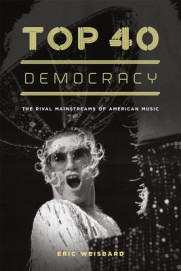 ERIC WEISBARD: When I started this project, as a history dissertation for UC Berkeley, my hope was to bring what history gives us—archival research, the chance to see things with the advantages of hindsight, an emphasis on working historiographically in conversation with other scholars—to bear on the rockism debate that Kelefa Sanneh’s New York Times article had inspired. The EMP Pop Conference had shown me how much revisionist popular music studies scholarship already existed, or was in process: Eric Lott, Elijah Wald, Richard Peterson, Guthrie Ramsey, Jr., Marybeth Hamilton, and many others. But nobody had looked at the years since the late 1960s with the same interest in replacing the kinds of distinctions that work when you’re writing about music in the present tense (good versus bad, progressive versus reactionary) with the perspectives we gain a generation or two later.
ERIC WEISBARD: When I started this project, as a history dissertation for UC Berkeley, my hope was to bring what history gives us—archival research, the chance to see things with the advantages of hindsight, an emphasis on working historiographically in conversation with other scholars—to bear on the rockism debate that Kelefa Sanneh’s New York Times article had inspired. The EMP Pop Conference had shown me how much revisionist popular music studies scholarship already existed, or was in process: Eric Lott, Elijah Wald, Richard Peterson, Guthrie Ramsey, Jr., Marybeth Hamilton, and many others. But nobody had looked at the years since the late 1960s with the same interest in replacing the kinds of distinctions that work when you’re writing about music in the present tense (good versus bad, progressive versus reactionary) with the perspectives we gain a generation or two later.
I decided that the way to do that was to write case studies of artists, radio stations, and record labels associated with music formats. Formats, the biggest of which in the 1970s and after have been Top 40, Adult Contemporary, country, rock, and R&B (with Latin joining in from the late 1990s as a big player), are a way for advertisers to reach a targeted set of listeners via a playlist of songs designed to please those listeners—to sing to them. The music doesn’t come first, at least not aesthetically: a demonstrably successful, which is to say profitable, act of cultural commerce does. That’s what makes formats different from genres, which value a coherent set of sounds as opposed to an identifiable audience. What makes studying formats so important is that this was the mechanism by which cultural industries, and the artists working within them, actually managed to accomplish something in music that didn’t happen so much in other categories of culture. Music created multiple, overlapping, and sometimes rival, mainstreams: different ways to feel normal at the same time. Formats are the structural underpinning of the world that poptimists celebrate and rockists deplore.
DH: Commercial radio stations are of necessity trying to please listeners, as you say, as well as sponsors. Sometimes their core listeners—genre partisans—will have interests at odds with those sponsors. An advertiser might prefer a smaller audience of big spenders, or a wider audience containing a somewhat disgruntled base. Several radio formats—country and R&B, for instance—need to maintain cultural, racial, and class affiliations while convincing advertisers that their listeners have an attractive amount of disposable income. So country radio needs genre signifiers—some steel guitars, some honky-tonk themes—but also needs to be genteel enough to court more prosperous listeners or at least convey an air, as it were, of prosperity. Your chapter on Dolly Parton, Nashville, and country radio tracks this constant push-pull between genre and format, past and present, idealism and pragmatism, what you call Parton’s “duet with modernity: impudence toward tradition and incorporation of heritage.” We saw these dichotomies in play when the neo-traditionalist acts of the ’80s—George Strait, Reba McEntire, Randy Travis, John Anderson, and the rest—revived country after the crossover boom ebbed. “Country the genre,” you write, “was saving country the format.” But we’ve seen this in many instances, yes?
EW: Every format has a different shape to it: uses music differently, because the audience that it speaks loudest to has different needs. So where rock, a format and a genre, rages against the machine—pretends to never be standardized, just as its listeners fantasize freedom from the norm—country has a more mixed set of ambitions. Country artists routinely thank country radio and “the industry” at awards shows. And that isn’t just cowardice: the “bulldozer South” C. Van Woodward wrote about, with its goals of modernizing and mainstreaming the nation’s most backward region, finds its voice in country at its slickest and most formatted. That’s the Dolly Parton who goes on the cover of Playboy, parties with drag queens, has country pop hits about checking out the sex party three doors down. But of course, Parton is also the traditionalist who records bluegrass albums and weepers with Victorian sentiments, who returns to the South from Hollywood in the mid-1980s to start Dollywood. And Nashville does the same thing: swings from moments that emphasize pop to moments that emphasize genre ties. Gender, I found, plays an interesting role in all of this. Men who cross over from country tend to flirt with rock: another genre, so their hardcore cred is not in question. Women who cross over flirt with AC or Top 40, so they are seen as impure!
DH: Yeah, exactly, and that’s one of the threads running through your book: condescension toward female taste, seen in sexist discourse to be capricious, undiscerning. Teenage boys refashion themselves as rebels or connoisseurs and abandon Top 40 to girls. Adult contemporary is dismissed as background music for Emma Bovary or Bridget Jones.
EW: One of the key stories of mainstream music that has never been told this way came to me as I researched A&M Records. From the late 1960s to late 1970s, nearly every artist that A&M turned into a smash seller—Herb Alpert & the Tijuana Brass, Carpenters, Captain & Tennille, Peter Frampton—fell with as much velocity as they rose. They were pop bubbles. And this turned out to be rooted in gender issues: male scorn for performers identified with women. When middle of the road music (the MOR format) became AC, adult contemporary, and that category solidified, more than just a name change was involved. The image of the female listener shifted in the industry’s mind: from a housewife to a white-collar office worker. And when that happened, some (not all) of the belittling went away. Performers like Sting, an AC perennial on A&M, or the label’s later discovery Sheryl Crow, fit the revised format. That’s kind of revolutionary, but none of our musical values let us see it that way.
DH: Your chapter on Cleveland’s pathbreaking station WMMS surveys rock radio from the often wistfully recalled days of freeform FM through a host of subsequent approaches, most notably an album-oriented rock attuned to the declining prospects of the city’s industrial worker and typified by Bruce Springsteen. Looking to grow revenue in ’83, the station transitioned from a rock station to a much more racially and otherwise mixed blend of rock and Top 40; by ’85, it was identifying as contemporary hit radio (CHR), the new industry term for Top 40. Much of the station’s male, working-class base was alienated, which leads you to raise one of the book’s many stimulating, unanswerable questions. “Was it politically progressive, given rock’s legacy of racism and sexism, or regressive, given the anti-working-class sales goals, for WMMS to play Michael Jackson?” It seems that part of the pleasure of writing this book was the chance to hold and deepen such uncertainties.
EW: That’s where rock is such a great subject for poptimism. Obviously, rock is pop: Metallica hold the all-time SoundScan albums record for their 1991 untitled album. Just as obviously rock is anti-pop: Metallica fans would mostly rather die than listen to the rival album, Shania Twain's Come on Over. We can view that as elitism, but the truth is that for Metallica to replace Led Zeppelin as the core artist of the mainstream rock format meant that working class white male listeners continued to demand a music that spoke to them. And the only company eager to provide that was the much demonized Clear Channel, now iHeartRadio, the megachain, which worked out a way to make enough ad money doing so. None of the more indie radio stations could do that—or at least none wanted to. When you bear down on the details of different mainstream sounds, seeing the histories and choices involved in creating and sustaining them, simplistic ideas about why radio should “take more chances” or some such tend to fade away pretty quickly. When broadcasters manage to numb us with repetition, some kind of cultural perspective has gained a political victory. Figure out who the winners (and losers) are: that’s better pop criticism than judging everything against some Pitchfork standard of good taste.
DH: Your chapter on the long, protean career of the Isley Brothers raises questions about how we evaluate continuity versus change, innovation verses trend-spotting. On one hand, we lionize restless artists who maintain a recognizable identity while shaping and reflecting their time—think of Miles Davis’s many incarnations from bop sideman to pioneer fusionist. On the other hand, relative changelessness is often seen as a sign of integrity. There’s something wonderfully inspiring about the Isley Brothers’ career: only a few of their records were unmistakably innovative, but they always seemed to come back around—Zeligs, as you say—with a necessary reflection of the Zeitgeist. That sort of responsiveness is undervalued.
EW: Rock and rollers remember the Isleys for fast songs: “Shout,” “Twist and Shout.” And they pleased everybody with “It's Your Thing” and “Fight the Power,” anthems of individualism and resistance designed to cross in all directions. But soul fans alone, which is to say a black public being given a national mainstream experience in the 1970s—by Soul Train, by slick LPs from Columbia Records that merited a good stereo system and spoke to the validation of corporate investment, by Frankie Crocker’s urban contemporary radio approach—soul fans remember something else. They remember slow songs designed to be heard in the bedroom. Songs you could rely on for romance and black communal identity. A formatted experience, but no less of a raced experience. The Isleys were all over the place during their career. But this moment was their most important, the place where in a way they stopped experimenting and found their formula. Formulaic music is malleable: hip-hop could sample the Isley Brothers, which is to say that music designed to sound classy appealed across the class divisions that threatened, but never overcame, African American identity.
DH: It seems that thinking about outsize celebrity ambition has softened. Growing up, I loved Elton John, Michael Jackson, Dolly Parton, and other extremely successful pop stars who grew up poor and show up in your book, but I also thought there was something ridiculous, something psychologically and morally dubious about their hunger for ever more fame and wealth. That fairly typical view was partly democratic, partly elitist. Treating developments during the Internet-fueled decline of the music business, you write, “the rockist rejection of established format categories accrued resale value because its putative anti-materialism asserted privilege. Musicians who lacked hit records and blamed tight radio playlists earned substantial licensing revenues when advertisers paid for their aura of exclusivity.”
It doesn’t seem that Beyoncé, for instance, is viewed quite in the light that skeptics, even skeptical fans, might have viewed earlier pop superstars. That’s progress for nuanced thinking, but perhaps a defeat as well?
EW: Commercial radio formats, and the major record labels that diversified to feed them, solidified around 1973, the most egalitarian moment for wealth balances in American history. It’s gotten worse since then, sometimes dramatically, and music formats are caught up in that story, as are pop superstars. Indie culture now reads as networked elite culture, which is to say the Mac from Superchunk who sang “Slack Motherfucker” is now the Mac from Merge Records helping revive Durham, North Carolina around notions of a creative-class economy. In a similar vein, Elton John used to be judged for betraying rock to seek Top 40; didn’t help that he was not out for much of the 1970s, so the ways in which sexuality informed his decision were either invisible to commentators or off the record. These days, we are beyond taking the Keith Richards position that Elton’s glamor and glitz sacrificed true artistry. We are more inclined to see how glamor and glitz is actually populist in a certain sense, at least compared to the hipster stuff that can be reinterpreted as premium product: like buying your cheese from Whole Foods. Is that a defeat? That’s one of the most challenging questions that Top 40 democracy presents to its critics. How do you oppose, in the name of cultural politics, a system that’s built on inclusivity, without embracing exclusivity?
DH: Discussions of mass culture invariably debate the extent to which taste is industrially manipulated or popularly developed. One standard teenage rant against pop is that it’s pabulum: record and radio execs use precedent, focus groups, and big budgets to manufacture hits, and the babyish general public acquiesces to repeated exposure and peer pressure. (A more generous, populist version says that people want more variety and challenge, but the industry won’t give it to them.) Of course, if the public were so malleable, the industry’s hits-to-misses ratio would presumably be higher, and obviously hits are often unexpected and indisputably audience-driven. What changes do you see in this regard so far during this century? The industry has access to more sophisticated research, but listeners and artists have many more ways to hear and promote music.
EW: I see no change in the cultural dynamic that created Top 40: the story, told again and again, about the waitress paying her own money into the jukebox to hear songs she’d heard all day long. Top 40, the format within all the other formats, has been the biggest winner of all in the 21st century on radio. Every new technological measurement teaches us that people want to hear familiar music from a relatively diverse set of sources. And the artists who can provide it—the singers, writers, producers, A&R people, sometimes combinations of all those categories—are finding levels of success that put almost all past music industry stories to shame, even as we are told that the Internet has destroyed everything.
Now, the devil is in the details: is my familiar music, meaning music that we can remember together and feel connected by, your oppressively overplayed crap? Is what I call relatively diverse something you call standardized to a fault? These are eternal questions. What I hope I’ve added is a sense of the perspective that comes by taking a longer view than the industry, or its critics, are used to taking. And from that perspective, this whole notion of commercial music as a structured form of marketing difference, mainstreaming group identity around songs and performers who capture an essence and a broadcast system that makes sure we hear the hits designed for us enough times for them to become ineradicable—all of that is pretty new. It’s really the story of how consumer society segmented to bring many sectors of the populace into the mix, first in the U.S. and now around the world. I’d never present that story as an absolute musical triumph, but I do think we can learn to appreciate its many folds and wrinkles.
Click here to purchase this book at your local independent bookstore

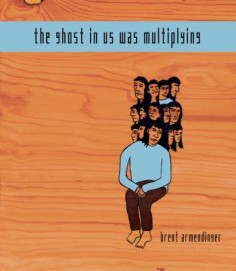 Brent Armendinger
Brent Armendinger

